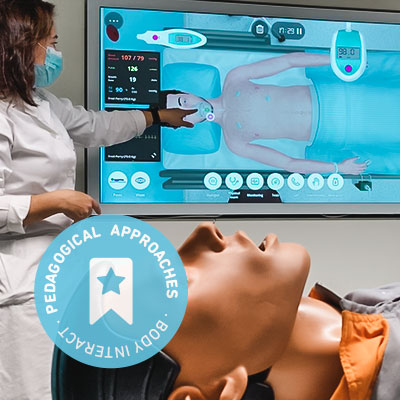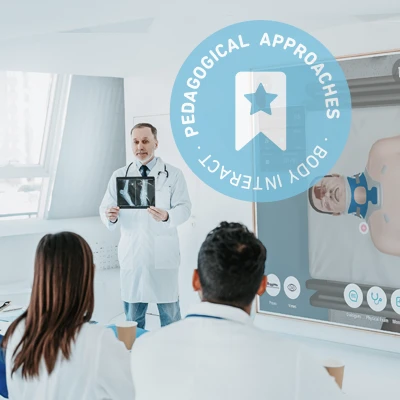Pedagogical Approach with Body Interact | Distance Learning
Online learning is not the next big thing;
it is the now big thing.”
Donna J. Abernathy, e-learning author and strategist
What is Distance Learning in Healthcare-Based Education?
Distance learning delivers instruction to learners who are geographically separated from instructors, using technology to ensure regular, meaningful, and academically valid interaction.
In healthcare education, this model supports skill development, curriculum continuity, and equitable access to clinical learning opportunities, even when in-person sessions are limited.
Key Aspects of Effective Distance Learning in Healthcare-Based Education
Although distance learning can be integrated as a regular part of the curriculum, it may also be used in an episodic or occasional manner. In either case, there are several essential elements needed to ensure effective and high-quality distance learning, namely:
- Interaction and Engagement: Planned, repeated, significant interactions between faculty and students (synchronous and/or asynchronous).
- Deliberate Course Design: Each element should align with the objectives, scaffold engagement, manage workload, and incorporate feedback opportunities.
- Assessment and Academic Integrity: Emphasize reasoning-rich tasks; use secure online assessment strategies and clear standards.
- Student Support and Community: Structures that reduce isolation and provide timely guidance and feedback should be considered.
- Quality Assurance: Continuous review of activities, data-informed improvement, and transparency.
- Accessibility and Equity: Technology choices and learning activities that accommodate diverse contexts are essential elements in Distance Learning Education.
How do Virtual Patients Fit a Distance Learning Approach?
Body Interact is a Virtual Patient Simulator with real-time physiological responses, cloud-based delivery (in-person, online, hybrid), multiplayer/team capabilities, assignment & tracking options (BI Studio – Learning Management System), and a scenario authoring tool – all useful levers and resources for distance learning.
There are different ways in which Virtual Patients are a valuable tool for Distance Learning Education:
- Asynchronous practice: Students can work on and practice cases at any time, make repeated attempts, and receive automated feedback, supporting self-directed learning and deliberate practice.
- Synchronous teaching: Professors can run clinical cases live (screen share), adding engagement moments (such as polls) throughout case discussion, then debrief.
- Assessment and analytics: Data collection (including decisions, timing, and outcomes of the patient) supports formative and summative assessment aligned with competencies.
- Curriculum integration: Virtual Patients align with curricular objectives and healthcare education standards, pre-briefs, checklists, and debrief rubrics; they can be embedded in LMS pathways.

Benefits of integrating virtual patients in distance learning
Below is a list of advantages of using Body Interact in a distance learning modality – some identified in the literature and others highlighted by professors who have implemented this approach. Let’s take a look:
- Continuous Clinical Exposure: Students can practice clinical reasoning remotely, maintaining regular exposure to patient scenarios even when in-person sessions are not possible.
- Flexible and Self-Paced Practice: Learners can access scenarios at any time, allowing them to revisit cases and consolidate and improve their knowledge [1]
- Standardized Learning Experiences: All students work through the same clinical cases, ensuring consistency in educational experiences regardless of location.
- Safe, Risk-Free Environment: Students can make decisions, test hypotheses, and learn from errors without compromising patient safety [2]
- Enhanced Engagement in Synchronous Sessions: Professors can run cases live, incorporate polls and decision checkpoints, and guide collaborative discussions that improve participation. [3]
- Real-Time Performance Feedback: The platform provides immediate feedback on clinical decisions, allowing learners to understand consequences and reasoning pathways.2
- Supports Active Learning Approaches: Body Interact promotes inquiry-based learning, problem-solving, and decision-making.
- Facilitates Collaborative Learning: Through shared case discussions, breakout groups, and guided debriefs, students engage in teamwork even when physically apart.
- Adaptable to Various Curricular Designs: It can be used for synchronous teaching, asynchronous assignments, remediation, assessment practice, or flipped classroom models.
- Trackable Progress and Analytics: Instructors can monitor student activity and performance, helping identify knowledge gaps and tailor instruction. [2]
- Maintains Continuity During Disruptions: Distance learning with Body Interact supports uninterrupted education during unexpected events such as pandemics or weather closures. [4]
Best practices: Implementing distance learning with virtual patients
When implementing Body Interact within a distance learning approach, the following suggestions can help you get the most out of this integration:
1. Promote the alignment of outcomes and blueprints
Map each Virtual Patient to specific competencies. Build case bundles that cover required conditions and presentations. [5]
2. Pre-brief > Virtual Patient > Debrief cycle
Provide objectives and resources up front; run the virtual patient; debrief with structured prompts (what went well/why, missed cues, alternative paths), tying decisions to evidence/guidelines. [5]
3. Blend synchronous and asynchronous
Use asynchronous Virtual Patient attempts for practice, use synchronous small-group sessions for teamwork and debriefing (supports presence and social learning). [6]
4. Assessment with integrity
Prioritize tasks that emphasize clinical reasoning—such as interpreting evolving data or distinguishing between competing diagnoses—rather than simple recall. Complement Body Interact performance analytics with written or oral reflections, and use scenario variants when assessments are high-stakes. [5]
5. Scaffolding and cognitive load
Start with guided cases; gradually remove supports, add time pressure, and increase ambiguity. (Online teaching reviews emphasize scaffolding.) [6]
6. Team-based learning
Use the multiplayer experience to practice communication and roles; assess both process and outcome.
7. Faculty development
Train faculty on the platform utilization, case facilitation, and debriefing online; share rubrics and exemplars.
6. Conduct QA
Monitor analytics (attempts, decisions, timing, outcomes), learner feedback, and assessment data; revise cases accordingly.
Real-World Example: Newcastle University
The Master of Nurse Practitioner Program, from the University of Newcastle – School of Nursing and Midwifery, in Australia, has integrated Body Interact Virtual Patients in its curriculum. This Program is offered exclusively online, promoting an engaging and rich learning experience to students from all corners of Australia. With a large participation of nurses from remote and rural areas, implementing a Virtual Patient Simulator in the program was, according to Professor Brandi Cole, “vital as this allows students to engage with the NPteaching team, their peers, and clinical supervisors in a ‘virtual clinical setting’ no matter their location.”

Master of Nurse Practitioner Program, University of Newcastle.
“The NP Teaching staff and student feedback is highly positive. Students appreciate the safety of the Body Interact, the ‘real life’ investigations and findings, and the variety in clinical presentations’.
Brandi Cole
BScPN, MMH(OP), MN(NP), PhD student, Nurse Practitioner Psychogeriatrics Senior Lecturer, Program Convenor Master’s of Nurse Practitioner Program. College of Health, Medicine and Wellbeing, School of Nursing and Midwifery. University of Newcastle
Conclusion
Effective distance learning in healthcare-based curricula depends on meaningful interaction, timely feedback, and opportunities for authentic clinical decision-making. Body Interact, with its real-time responses, multiplayer option, and comprehensive debriefing and analytics, equips educators to meet regulatory expectations, maintain learner engagement, and develop clinical reasoning at scale, no matter where students are located.
References
1. Cook DA, Erwin PJ, Triola MM. Computerized virtual patients in health professions education: a systematic review and meta-analysis. Acad Med. 2010 Oct;85(10):1589-602. doi: 10.1097/ACM.0b013e3181edfe13. PMID: 20703150.
2. Berman NB, Durning SJ, Fischer MR, Huwendiek S, Triola MM. The Role for Virtual Patients in the Future of Medical Education. Acad Med. 2016 Sep;91(9):1217-22. doi: 10.1097/ACM.0000000000001146. PMID: 26959224.
3. Rothlind, E., Fors, U., Salminen, H. et al. Virtual patients reflecting the clinical reality of primary care – a useful tool to improve cultural competence. BMC Med Educ 21, 270 (2021). https://doi.org/10.1186/s12909-021-02701-z
4. Goudarzi, H., Onozawa, M. & Takahashi, M. Impact of the Covid-19 pandemic and ensuing online teaching on pre-clinical medical education. BMC Med Educ 24, 66 (2024). https://doi.org/10.1186/s12909-023-04967-x
5. WFME. Standards for Distributed and Distance Learning in Medicine (2021). wfme.org
6. Sahu PK, Dalcik H, Dalcik C, Gupta MM, Chattu VK, Umakanthan S. Best practices for effective implementation of online teaching and learning in medical and health professions education: during COVID-19 and beyond. AIMS Public Health. 2022 Jan 27;9(2):278-292. doi: 10.3934/publichealth.2022019. PMID: 35634030; PMCID: PMC9114788.









